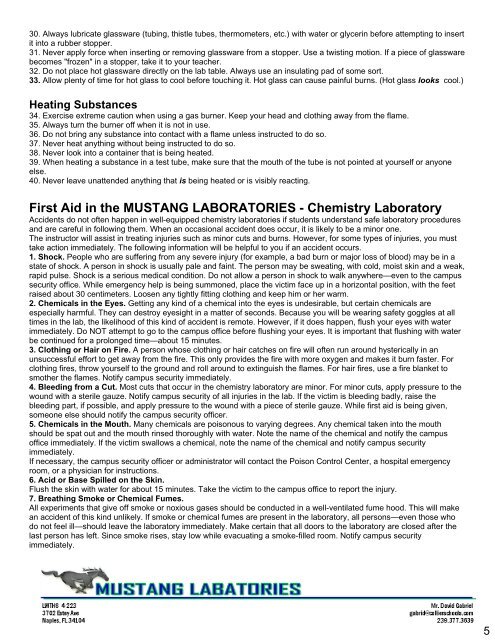Create successful ePaper yourself
Turn your PDF publications into a flip-book with our unique Google optimized e-Paper software.
30. Always lubricate glassware (tubing, thistle tubes, thermometers, etc.) with water or glycerin before attempting to insert<br />
it into a rubber stopper.<br />
31. Never apply force when inserting or removing glassware from a stopper. Use a twisting motion. If a piece of glassware<br />
becomes "frozen" in a stopper, take it to your teacher.<br />
32. Do not place hot glassware directly on the lab table. Always use an insulating pad of some sort.<br />
33. Allow plenty of time for hot glass to cool before touching it. Hot glass can cause painful burns. (Hot glass looks cool.)<br />
Heating Substances<br />
34. Exercise extreme caution when using a gas burner. Keep your head and clothing away from the flame.<br />
35. Always turn the burner off when it is not in use.<br />
36. Do not bring any substance into contact with a flame unless instructed to do so.<br />
37. Never heat anything without being instructed to do so.<br />
38. Never look into a container that is being heated.<br />
39. When heating a substance in a test tube, make sure that the mouth of the tube is not pointed at yourself or anyone<br />
else.<br />
40. Never leave unattended anything that is being heated or is visibly reacting.<br />
First Aid in the MUSTANG LABORATORIES - <strong>Chem</strong>istry Laboratory<br />
Accidents do not often happen in well-equipped chemistry laboratories if students understand safe laboratory procedures<br />
and are careful in following them. When an occasional accident does occur, it is likely to be a minor one.<br />
The instructor will assist in treating injuries such as minor cuts and burns. However, for some types of injuries, you must<br />
take action immediately. The following information will be helpful to you if an accident occurs.<br />
1. Shock. People who are suffering from any severe injury (for example, a bad burn or major loss of blood) may be in a<br />
state of shock. A person in shock is usually pale and faint. The person may be sweating, with cold, moist skin and a weak,<br />
rapid pulse. Shock is a serious medical condition. Do not allow a person in shock to walk anywhere—even to the campus<br />
security office. While emergency help is being summoned, place the victim face up in a horizontal position, with the feet<br />
raised about 30 centimeters. Loosen any tightly fitting clothing and keep him or her warm.<br />
2. <strong>Chem</strong>icals in the Eyes. Getting any kind of a chemical into the eyes is undesirable, but certain chemicals are<br />
especially harmful. They can destroy eyesight in a matter of seconds. Because you will be wearing safety goggles at all<br />
times in the lab, the likelihood of this kind of accident is remote. However, if it does happen, flush your eyes with water<br />
immediately. Do NOT attempt to go to the campus office before flushing your eyes. It is important that flushing with water<br />
be continued for a prolonged time—about 15 minutes.<br />
3. Clothing or Hair on Fire. A person whose clothing or hair catches on fire will often run around hysterically in an<br />
unsuccessful effort to get away from the fire. This only provides the fire with more oxygen and makes it burn faster. For<br />
clothing fires, throw yourself to the ground and roll around to extinguish the flames. For hair fires, use a fire blanket to<br />
smother the flames. Notify campus security immediately.<br />
4. Bleeding from a Cut. Most cuts that occur in the chemistry laboratory are minor. For minor cuts, apply pressure to the<br />
wound with a sterile gauze. Notify campus security of all injuries in the lab. If the victim is bleeding badly, raise the<br />
bleeding part, if possible, and apply pressure to the wound with a piece of sterile gauze. While first aid is being given,<br />
someone else should notify the campus security officer.<br />
5. <strong>Chem</strong>icals in the Mouth. Many chemicals are poisonous to varying degrees. Any chemical taken into the mouth<br />
should be spat out and the mouth rinsed thoroughly with water. Note the name of the chemical and notify the campus<br />
office immediately. If the victim swallows a chemical, note the name of the chemical and notify campus security<br />
immediately.<br />
If necessary, the campus security officer or administrator will contact the Poison Control Center, a hospital emergency<br />
room, or a physician for instructions.<br />
6. Acid or Base Spilled on the Skin.<br />
Flush the skin with water for about 15 minutes. Take the victim to the campus office to report the injury.<br />
7. Breathing Smoke or <strong>Chem</strong>ical Fumes.<br />
All experiments that give off smoke or noxious gases should be conducted in a well-ventilated fume hood. This will make<br />
an accident of this kind unlikely. If smoke or chemical fumes are present in the laboratory, all persons—even those who<br />
do not feel ill—should leave the laboratory immediately. Make certain that all doors to the laboratory are closed after the<br />
last person has left. Since smoke rises, stay low while evacuating a smoke-filled room. Notify campus security<br />
immediately.




